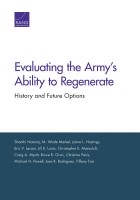| 来源类型 | Research Reports
|
| 规范类型 | 报告
|
| DOI | https://doi.org/10.7249/RR1637
|
| ISBN | 9780833096630
|
| 来源ID | RR-1637-A
|
| Evaluating the Army's Ability to Regenerate: History and Future Options |
| Shanthi Nataraj; M. Wade Markel; Jaime L. Hastings; Eric V. Larson; Jill E. Luoto; Christopher E. Maerzluft; Craig A. Myatt; Bruce R. Orvis; Christina Panis; Michael H. Powell; et al.
|
| 发表日期 | 2017
|
| 出版年 | 2017
|
| 页码 | 120
|
| 语种 | 英语
|
| 结论 |
Current Policy Levers Will Probably Suffice to Enable Regeneration- Relatively quick regeneration of the active component would carry a number of risks, particularly when expanding from a Total Army of 920,000.
- Potentially the most critical risk revolves around the fact that while the Regular Army is expanding, the Army as a whole will still need to meet operational demands.
External Conditions Can Substantially Affect the Difficulty of Recruiting- A good civilian labor market is generally bad for Army recruiting, and vice versa.
- Public support for the conflict is also likely to affect the difficulty of recruiting.
Regeneration Would Stress the RC, Especially When Starting from 920,000- All regeneration scenarios we considered would require the RC to rotate above a 1:3 mobilization-to-dwell ratio for a number of years.
|
| 摘要 |
- Develop and resource specific capabilities to enable regeneration of the active component.
- Assess alternative ways to posture the Army for regeneration of the active component.
- Prepare the RC for rapid and high-frequency deployment while the Army is focused on quickly expanding the active component.
- Maintain certain critical skills that have a long lead time for training to reduce the stress placed on the Army during regeneration of the active component.
- Maintain Army capacity for contingency contracting, as the need to contract out support and sustainment capacity may well increase as Army operating forces decrease.
- Develop contingency plans that, for example, include greater mobilization of the RC if active component regeneration falters.
- A decision to regenerate should be made as early as possible during a conflict so that policy levers can be put in place quickly. A decision to go to war should be a decision to expand the Army's active component.
|
| 主题 | Enlisted Personnel
; Military Personnel Retention
; Military Recruitment
; Military Reserves
; Military Transformation
; United States Army
|
| URL | https://www.rand.org/pubs/research_reports/RR1637.html
|
| 来源智库 | RAND Corporation (United States)
|
| 引用统计 |
|
| 资源类型 | 智库出版物
|
| 条目标识符 | http://119.78.100.153/handle/2XGU8XDN/108507
|
推荐引用方式
GB/T 7714 |
Shanthi Nataraj,M. Wade Markel,Jaime L. Hastings,et al. Evaluating the Army's Ability to Regenerate: History and Future Options. 2017.
|
|
文件名:
|
x1495316792155.jpg
|
|
格式:
|
JPEG
|

|
文件名:
|
RAND_RR1637.pdf
|
|
格式:
|
Adobe PDF
|
除非特别说明,本系统中所有内容都受版权保护,并保留所有权利。